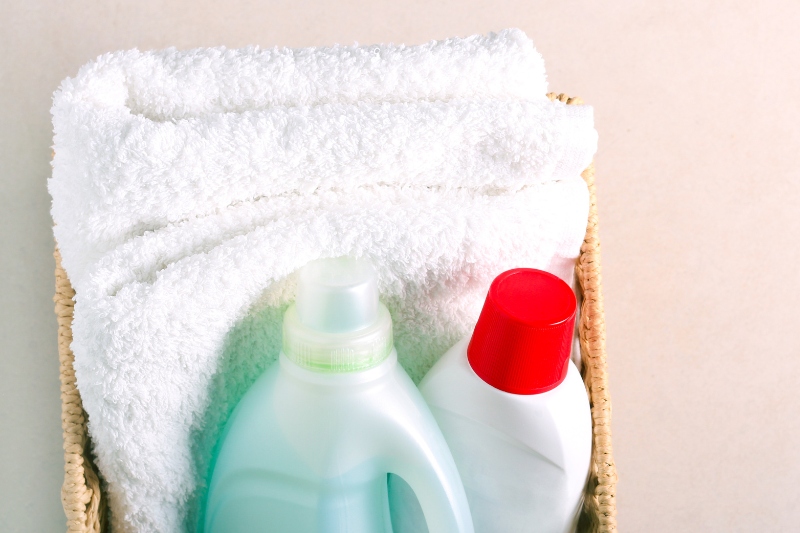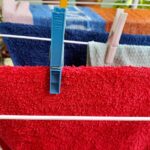Washing towels seems straightforward enough, and to a degree it is a simple process. However, there are a few dos and don’ts that you should adhere to when it comes to keeping towels clean.
Not only will following the rules keep your towels hygienic, but it’ll also protect their lifespan, absorbency, and give them a much softer feel. Find out how to clean towels below!
The ‘Dos’ of Washing Towels
- Always wash new towels before you use them. This is essential, so don’t skip this stage! You don’t know what germs or product residue could be lurking on your new towels, even if they look spotless.
- Hang wet towels up after you’ve used them if you’re not going to wash them straight away.
- Half the amount of detergent you use when washing towels.
- Always take your freshly washed towels out of the washer and dry them immediately. If you leave damp towels in a washing machine, they can start to smell stale!

The ‘Don’ts’ of Washing Towels
- Don’t just leave wet towels hanging around the bathroom, or sitting in a pile in the corner of a room. This is going to encourage mould to grow. Plus, the towels will start to stink after a while. Yucky!
- Don’t pour lashings of detergent into the washer when you’re cleaning towels. Too much detergent can leave a filmy residue on towels and can actually make them feel tough.
- After washing your towels, dry them immediately. Don’t leave them sitting around in the washer as this can encourage mould!
- Try not to overload your washing machine with towels. An overloaded washer may not clean the towels correctly!
- Don’t use fabric softener as it will make your towels less absorbent. In turn, the towel won’t be very effective at drying your body after a shower.
How to Wash Towels in a Washing Machine
Cleaning your towels in the washing machine is one of the easiest ways to wash them. But before you dive into cleaning your towels in this manner, you better make sure that your towels are washer safe!
Steps to follow:
- Check the tags on your towels to see how they should be washed and dried.
- Separate your coloured towels from your white towels. Wash each pile separately, so you don’t have any colour run mishaps!
- Select a long hot wash cycle (the hottest setting permitted for the material would be ideal – normally around 40°C to 60°C). But if your towels have tassels or patterns, you may need to use cold water.
- Add half a normal measure of biological detergent to the washer (a detergent like Persil Bio would work). By cutting the dose in half you can stop the detergent from building up on your towels and making them feel stiff.
- Add a laundry sanitiser to the washer’s drawer to make the towels extra sanitary, if you like. Something like Dettol Antibacterial Laundry Cleanser would do the trick.
- Pop a pile of towels inside the drum.
- Start the wash cycle.
- Don’t add fabric softener as this can impact the absorbency of your towels.
- Optional: Add a quarter of a cup of white vinegar to the wash to soften the towels. It’s not essential for you to do this for every single wash. You can do this every few washes!
- Optional: Add half a cup of bicarbonate of soda to the drum to deodorise towels. This can be done now and again, or when your towels are extra smelly.
- Optional: You can bleach towels, but make sure you use a colour-safe oxygen bleach and always do a patch test first! You don’t need to do this every single time you wash your towels, every so often would do.
- When the cycle ends, remove the towels from the washing machine, shake each towel out, and dry them – line dry, tumble dry or pop them on a heated airer.
- If you plan on drying your towels outdoors, remove your towels from the line before they over-dry and go stiff, pop them in the dryer, and start a 15-minute cycle. This’ll help to fluff the towels up.
- If you plan on tumble drying your towels, add a couple of dryer balls to the drum to agitate the towels as they spin around.
- Make sure that all your washed towels are completely dry before you store them.
Note: Make sure you don’t add too many towels to your washer, as this can hinder the cleaning process. A consequence of overloading the drum is that some detergent may not be rinsed off the towels correctly. A build of detergent, in turn, can make the towels feel quite scratchy – this isn’t exactly the type of towel you want to wrap yourself in after being in the bath!

How to Wash Towels by Hand
Hand-washing towels is a great alternative to washing them in a washing machine. However, this method does take longer to complete, and is arguably a more tiring cleaning process.
So, if you’re going to go down this route make sure you have plenty of time to dedicate to the task, and above all else, be patient.
To wash towels by hand you will need to source and clean a large bucket or bathtub in preparation.
Once the cleaning area is free from dirt, you can fill it up with lukewarm or cold water. You will then need to add half a measure of detergent to the water and add the towels in.
You can leave the towels to rest in the soapy liquid for a few minutes, and after a while you can start to knead and agitate the towels with your hands (wear gloves).
This process may take some time as you clean each individual towel thoroughly. It may also be quite a tiring process to carry out, especially when you’re cleaning bulky towels that absorb a lot of water.
Once the towels have been cleaned, you will need to wring them out. This can be done by hand, but it is far easier to use a wringer to do this because the towels will hold a lot of water and will be heavy!
After you’ve drained the dirty water away, you can fill the bucket/bathtub up with more fresh water that is detergent-free, and you can re-submerge the towels in the liquid.
The towels will need to be kneaded a little, so you can dislodge any detergent from the fibres. (You may have to repeat this rinsing process a few times to remove all of the residual detergent).
When the water no longer changes colour and is completely suds free, you know you’ve cleaned all the detergent off the material. You can then wring the towels out and move on to drying them.
You can either line dry, tumble dry or use a heated airer to dry your towels. Just make absolutely sure that your towels are actually dry before you pop them away.
Washing New Towels

How to wash new towels before using them
It’s a good idea to wash new towels before using them for the first time. This will remove any chemical coating and make them more hygienic to use.
The first step you should always take when washing new towels is to read their care label. The small tag, usually found near one of the towel’s corners, will tell you how to wash your towel and how to dry it.
After doing this you can add some white distilled vinegar to your washer’s drawer, pop the towels in the drum, and start a cycle. Once this initial cycle has been done you can run another cycle, but this time add bicarbonate of soda to the drum instead of vinegar.
Once you’ve carried out these initial steps you can launder your towels as normal.
How to make new towels more absorbent
New towels aren’t always as absorbent as you’d like them to be. And this is normally just a sign that the towels are coated in some product residue (said products would’ve been used during the manufacturing process). But don’t worry, there’s a simple solution to solve this issue.
All you need to do is read the tag on your new towels, find out how they need to be washed, add them to the washing machine’s drum, and start a cycle. You don’t need to add anything else to the drum during this cycle – you can even leave out the detergent!
After this initial cycle has been completed, you can run the same cycle again, but this time add some distilled white vinegar to the washer. This is going to clean any remaining dirt away and soften the towels. Once this cycle has finished you can re-run the cycle, if you like!
As a final step you can run another cleaning cycle, but this time you can add some bicarbonate of soda to the drum. Your towels can then be dried!
How and Why to Strip Towels

Stripping towels may not seem like something you need to do, but it should become a regular part of your cleaning routine. Why?
By stripping your towels, you remove even more dirt from them, this includes oils, detergent, mineral deposits, dirt and odours. And although you’d assume that a normal washing cycle would do all of this, it isn’t always the case. There is often hidden grime left behind on towels after they’ve been laundered, and you need to get rid of this so you can make your towels more hygienic.
The stripping process isn’t too difficult to carry out, it only needs to be done a few times a year, and it’s relatively straightforward to do.
All you need to do is choose a product(s), add it to some water, and pop the towels in the water for a few hours at a time. You can use a mix of Borax Substitute, soda crystals and detergent or bicarbonate of soda, water, and vinegar to strip your towels.
FAQs on Washing Towels

Is fabric softener bad for towels?
Fabric softener can leave towels smelling fresh, but it can also impact their absorbency. Given the fact that you want your towels to be extra absorbent, it would be unwise to coat them in something that is going to make them less absorbent!
You should avoid using fabric softener, and you should find an alternative product to soften your towels instead. You could use distilled white vinegar, dryer balls, or water softeners, for example.
How often should you wash towels?
According to Consumer Reports you should clean your towels after three to four normal uses (provided that these towels are hung up to dry in between uses, and they’re not thrown in a heap on the floor).
However, if you feel the need to increase this frequency you can do so! Some households wash their towels after a single use. And although some would argue that there’s no need to do this, it does come down to personal preference.
As a rule, you shouldn’t really leave your towels to sit, unwashed for too long because they can quickly become overrun with germs. Also, wet towels encourage mould growth, so you don’t want to leave soaking wet towels in the bathroom/washing basket for too long.
So, clean your towels frequently and dry them in between uses, if you don’t wash them immediately.
How can you keep towels soft?

There are a number of ways you can keep your towels soft, including the following:
- Only use half the amount of detergent you would normally use when laundering your towels.
- Use white vinegar to keep your towels feeling smooth.
- Rotate your towels frequently, so you use a different batch each week.
- Only wash towels together.
- If you live in a hard water area, consider using a water softener.
- Air dry towels but pull them in just before they go dry, so you stop them going crunchy!
- Lower the water temperature on your washer.

Bethan has a passion for exploring, reading, cooking and gardening! When she’s not creating culinary delights for her family, she’s concocting potions to keep her house clean!






